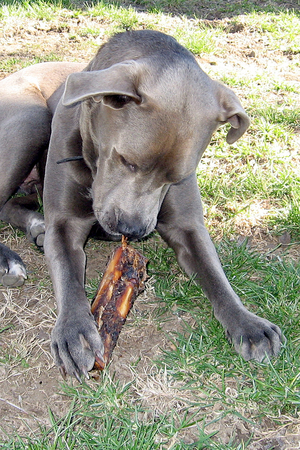Whether to throw the dog a bone, or not–that is the question posed by the United States Food and Drug Administration.
The Dangers
In an April 2010 consumer update the FDA warned pet owners of the potential dangers of natural bones. From broken teeth to internal blockages, bones fed to dogs without supervision can indeed cause a health hazard.
The report highlights the expensive cost of veterinary care for mouth, tongue and teeth injuries. Sutures to close mouth wounds, repairing cracked teeth and anesthetization to remove circular shaped bones wedged over the jaw of long-snout dog breeds are just a few dangers posed by bone-chewing.
Surgery may also be required to remove bone fragments lodged in the esophagus, stomach, intestines or anywhere in between. Constipation, bleeding of the rectum and a bacterial infection of the abdomen known as peritonitis can effect dogs who eat natural bones.
Carmela Stamper D.V.M, a veterinarian in the Center for Veterinary Medicine at the Food and Drug Administration, recommends finding an alternative to natural animal carcass bones.
“There are many bone-like products made with materials that are safe for dogs to chew on,” Stamper stated in the report.
Nylon, rubber, ground-compressed rawhide and corn starch-based bones are readily available at pet superstores such as Petco and PetSmart.
The Benefits
Advocates of safe pet practices argue bone-chewing is a natural part of a dog’s instinctual diet.
Chewing natural bones is nature’s form of dog dental care, according to Randy Kidd, D.V.M, Ph.D.
Dog owners who feed bones almost universally report cleaner teeth and fewer trips to the vet for routine dental work, ” Kidd noted in his article “Dem Bones” online at Dog Channel.com.
Chewing bones also exercises the dog’s jaws, face and tongue muscles. Cartilage tissue attached to some natural bones is a healthy source of joint-improving chrondroiton.
Kidd recommends feeding fresh raw bones that haven’t been weakened by cooking. Heated bones are more likely to splinter, fracture and cause health problems for the dog.
To reduce the chance of choking select bones much larger than the dog’s mouth and remove any small pieces that break away from the bone.
All Bones
The abrasive action of chewing bones, whether they are natural or man-made, reduces tartar and plaque build-up, according to Race Foster, D.V.M on the Pet Education website.
Dogs need to chew. It is an undeniable internal instinct. No matter what type of bone ends up on your dog’s dinner plate it will help satiate the dog’s desire to chew and relieve boredom.
In our practice, the vast majority of dogs we see and treat for dental problems are dogs that have not chewed on enough hard objects, whether they are toys or bones,” Foster noted.
References and Suggested Further Reading:
Food and Drug Administration (FDA): No Bones About It: Bones are Unsafe for Your Dog
http://www.fda.gov/ForConsumers/ConsumerUpdates/ucm208365.htm
Doctor’s Foster and Smith Pet Education: Chew Bones: The Many Benefits & How to Choose One
http://www.peteducation.com/article.cfm?c=2+2098&aid;=811
Dog Channel: Dem Bones
http://www.dogchannel.com/media/holistic-dog-care/dem-bones.aspx.pdf
###
Reference:
- Why Dogs Eat Dirt: www.associatedcontent.com/article/2918286/why_dogs_eat_dirt.html?cat=53
- DIY Dog Bed Ideas: www.associatedcontent.com/article/2553109/diy_dog_bed_ideas.html?cat=53
- Natural Flea Prevention Ideas for Dogs: www.associatedcontent.com/article/293487/natural_flea_prevention_ideas_for_dogs.html?


